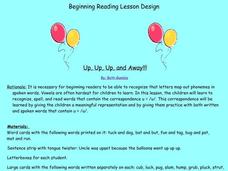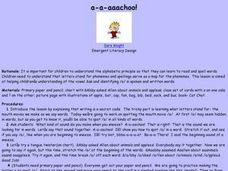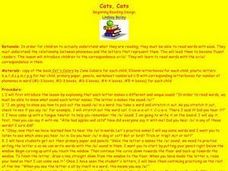Curated OER
Shiny Shells on the Shore
Students investigate how: A single phoneme, which is a vocal gesture in spoken words, can be represented by more than one grapheme. Also how a digraph is the combination of two letters that make one sound (there are both vowel and...
Curated OER
Aaaa! The Baby is Crying!
Students discover the correlation between graphemes and phonemes. They distinguish phonemes in verbal word contexts and match the letters to the phonemes. They focus on working to recognize the phoneme /a/ in its oral and written form.
Curated OER
Can You Open the Creaky Door?
Students recognize the short vowel e in written and spoken language. Through matching and listening activities, they discriminate the vowel sound /e/ from other phonemes. Students identify the phoneme and letter in words and pictures.
Curated OER
Up, Up and Away
Students recognize the short vowel u in written and spoken language. Through matching and listening activities, they discriminate the vowel sound /u/ from other phonemes. Students identify the phoneme and letter in words and pictures.
Curated OER
Boo.....AAAaaaa!!!
Young scholars complete a variety of activities related to the short /a/ sound. As a class they recite a tongue twister, then trace and write the letter A. Students then listen to word pairs and identify the word containing the short /a/...
Curated OER
Icky Fingers
Students are introduced to digraphs so they can match letters to their phonemes. They recognize the short vowel i=/i/ in both spoken and written words by practicing reading and spelling words containing /i/. Elkonin Letter Boxes are...
Curated OER
Cry Baby
Students complete a variety of activities related to the short /a/ sound. As a class they recite a tongue twister, then trace and write the letter A. Students then listen to the book "A Cat Nap" and identify the words containing the...
Curated OER
Elephants Enjoy Eating Eggs
Students recognize the short vowel e in written and spoken language. Through listening and matching activities, they discriminate the vowel sound /e/ from other phonemes. Students practice using the phoneme and letter in words by writing...
Curated OER
AAAAAAAAAAA! Stop Crying!
Learners practice recognizing the phoneme /a/ in spoken words. They interact with the book, "A Cat's Nap," and a poster with Abby and Allen on it that are asking animals for apples, and cards with words on them like at, mad, went, bag,...
Curated OER
Eddie the Elephant
Students need to practice sight words to become proficient readers. So it is very important for children to learn common correspondences. The phoneme for the letter "e" is practiced in this lesson.
Curated OER
Eeeee -- It's a Mouse!
Students recognize the long "e" sound, and identify it in spoken words by learning letter symbols. Students participate in role playing and tongue twisters to learn the long "e" sound. By learning phenomes, students are taking the...
Curated OER
Cry Baby
Students complete a variety of activities related to the short /a/ sound. They listen to a list of words and identify the words containing the short /a/ sound, and write the letter A. Students listen to the book "Cat Nap" and identify...
Curated OER
A-a-aaachoo!
Students complete a variety of activities related to the short /a/ sound. As a class they recite a tongue twister, and trace and write the letter A. Students then view a stack of picture cards and identify the words containing the short...
Curated OER
Cats, Cats
Students complete a variety of activities related to the short /a/ sound. As a class they recite a tongue twister, then trace and write the letter A. Students then spell different words containing the short /a/ sound, listen to the book...
Curated OER
"HiSS"terical Snakes
Students explore the /s/ sound on the end of words. They discuss the phoneme /s/. Students listen for /s/=s at the beginning, middle and end of words. They write the letter s and practice reading and writing words containing /s/.
Curated OER
Pooh's Rumbling Tummy
Students recognize the short vowel u in written and spoken language. Through matching and listening activities, they discriminate the vowel sound /u/ from other phonemes. Students identify the phoneme and letter in words and pictures.
Curated OER
Zigby Zigzags
Students complete a variety of activities related to the /z/ sound. As a class they recite a Z tongue twister, then listen to the book Zigby Hunts For Treasure. Students identify the words in the book containing the /z/ sound, trace and...
Curated OER
Ehhh! Can you repeat that!
Students assess how to recognize phonemes that stand for letters creating spoken words utilizing the short vowel /e/. They associate our written language as a secret code to solve. The tongue twister "Everybody saw Eddie and the Eskimo...
Curated OER
Laugh at the Cat!
Students complete a variety of activities related to the short /a/ sound. As a class they recite a tongue twister, then trace and write the letter A. Students then play a concentration matching game, listen to the book "Cat Traps," and...
Curated OER
Red is My Pet!
Learners complete a variety of activities related to the short /e/ sound. As a class they recite a tongue twister, and write the letter E. Students then listen to the book "Red Gets Fed," and identify the words in the story that...
Curated OER
The "B" Box
Students complete a variety of activities related to the letter B and the /b/ sound. As a class they recite a tongue twister, and identify objects from a box that have the /b/ sound in their name. Students also listen to the story...
Curated OER
Crying Baby Sound
Students recognize the short vowel a in written and spoken language. Through matching and listening activities, they discriminate the vowel sound /a/ from other phonemes. Students identify the phoneme and letter in words from the story...
Curated OER
Ta-Ta- Timer
Students identify a letter of the alphabet. They recognize this letter in print and in spoken language. The letter and phoneme chosen is the letter t and /t/. They write the letter in both lower and upper case. They read 'One Tiny...
Curated OER
Don't Punch Too Hard
Young scholars recognize the short vowel u in written and spoken language. Through matching and listening activities, they discriminate the vowel sound /u/ from other phonemes. Students identify the phoneme and letter in words and pictures.

























